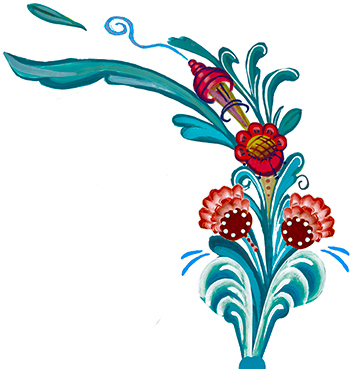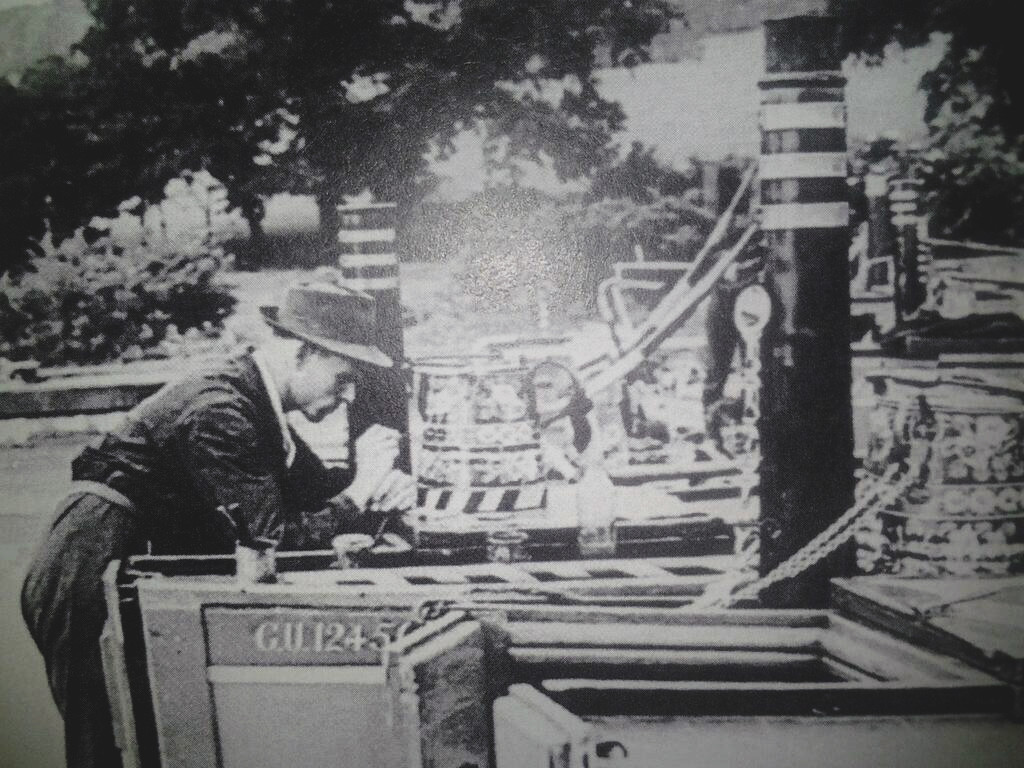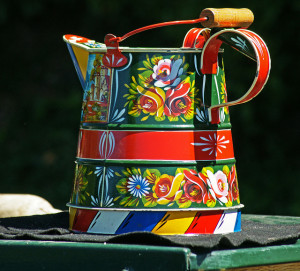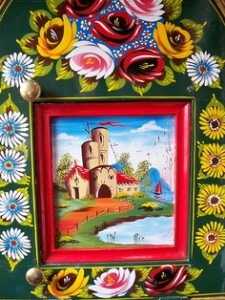Nobody knows for certain where the tradition and style of Roses & Castles painting came from. Many people have tried to establish links with the Romany Gypsy culture and their highly decorative painted caravans. However, some historians have also identified similarities with folk art from Germany, Holland and even parts of Asia.
Some individuals have pointed out the close similarity between Roses and Castles and the old Swedish art form called Kurbits (an example of which is shown below). However, whatever its origin, one reason for its popularity amongst the canal families who used to ply their trade on the UK canals was the intensity of colour which brightened even the smallest boat cabin.
 By the second half of the 19th century it had become the fashion to paint roses and castles on the narrow boats themselves as well as their fixtures and fittings. When you looked at decorated narrowboats, one of the most common places roses and castles were painted were the doors to the cabin.
By the second half of the 19th century it had become the fashion to paint roses and castles on the narrow boats themselves as well as their fixtures and fittings. When you looked at decorated narrowboats, one of the most common places roses and castles were painted were the doors to the cabin.
They could also be seen on the Buckby water can found on the roof (which contained the families domestic water supply) and were often continued onto the side of the boat with the boat’s name. Today, this tradition is carried on with most narrowboats having fairly ornate lettering showing the boat’s name and owner. Strangely, this tradition of painting roses and castles on the boat was not carried out right across the country and for example, the Chesterfield Canal was one waterway where the narrowboats never bore such decorations.
In addition to the familiar Roses and Castles, other flowers were also a popular item of decoration on all sorts of domestic wares and wall coverings etc. – Landscapes, which incorporated fields, together with water, hills and cottages, were frequently seen on utility ware and papier-mâché articles produced at the time. Glancing in the rear of a true traditional narrowboat an observer would see in addition to the ornate painting, a variety of lace – often around the shelves, as well as pierced edged plates and highly polished brassware. These were often no more than decorative brass door handles, but they brought some sparkle and glamour into an otherwise dull cabin interior.

Charlie Green painting a Buckby Can – photo courtesy of Peter Batchelor
Some individuals who applied this decorative paint finish would work predominantly on boat building and repair docks. They usually did a variety of other jobs around the dock, with the most talented artists being given the task of decorating the boats with paint that was made up from ground pigments as required.

The principal reason for the highly decorated boats tended to be the desires of the wives (and other women folk of the boatmen) to make the limited space available seem bright and attractive. There was also their desire to appear as cultivated and refined as possible. This was most apparent as many narrow boaters wanted to demonstrate to Victorian land-dwellers (who had a tendency to look down their noses at the itinerant bargees) that they had a culture of their own…
Broadly speaking, the outside of boats owned by Companies tended to have rather large lettering and scrollwork, which were often outlined with geometric patterns. This approach is logical when you think about it, as most were anxious to promote their own carrying companies. These were working boats after all, and the name formed part of the Company’s advertising.
Roses and castles were therefore generally reserved for the interiors, but some individual owner-operators (known as Number Ones) had a tendency to have their boats decorated quite lavishly on the outside as well.

While the practice of decorating narrowboats declined as commercial use of the canals dwindled, it has seen something of a re-emergence in recent years with the growth of leisure boating and private ownership.
Narrowboats decorated with roses and castle themes are a fairly common sight on today’s canals, but many of these use cheaper computer-printed vinyl transfers in place of the traditional craft of hand-painted designs.
However – it is still possible to learn the techniques practiced by boat painters all those years ago, and a series of specialist classes take place at various canal associated centres around the country.

just started on my first roses and castle painting!
I absolutely love these boats and have recently finished the blueprints for my own design to build one. It will retain nostalgia, yet still incorporate hidden, new technology for safety and economy.
After my recent learning of Roses & Castles hand painted on the vessels, I will definitely look for an artist to help me with that..
It’ll likely take a year or two to build, but if this website is still around, I’ll post it here, once finished..
Thanks for reading!
Ed Goldrush USA
Lovely piece. Thanks for sharing. I make projects from recycled wood but have one non wood related one at the moment where I need to paint an old coal scuttle (I thought flowers on a creme background). Have you any advice on whether it should be gloss or enamel paint and does the galvanised scuttle need a primer first? It’s my first attempt at such things.
Blimey Tim – I’m not an artist by any stretch of the imagination, but I would ask if any other visitor to the site can give you the advice you are asking for…
Colin